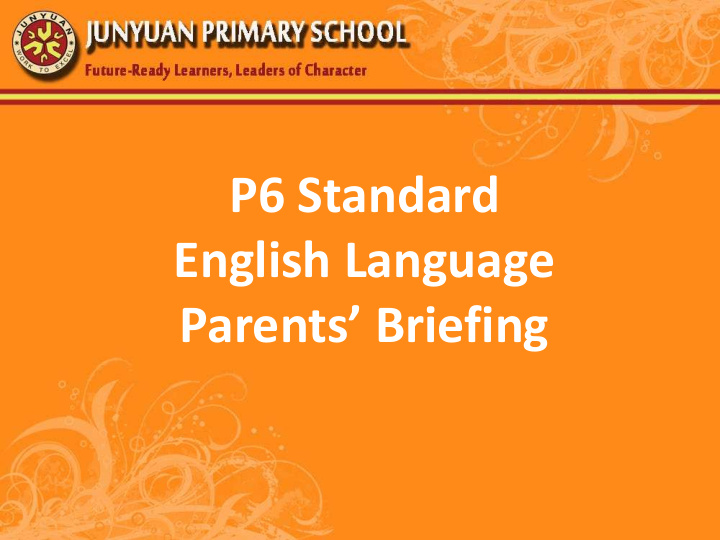



P6 Standard English Language Parents’ Briefing
STELLAR Strategies for English Language Learning and Reading The EL instructional programme for primary schools that provides the instructional materials, teaching strategies and training to enable teachers to implement the EL syllabus. Aims to move EL learners towards independence using authentic texts and learning activities that motivate and engage different learners
Desired Junyuan Outcomes Confident Communicator P6 – Public Speaking Held in Term 2
Rubrics (Confident Communicator)
Key Department Strategies • Modular Writing – Theme-based which is closely related to Stellar units. E.g. Integrity, Accomplishment, Embarrassing situation • Visible Thinking Routines – A flexible approach to integrating the teaching and development of thinking with content and curriculum. These core routines target different types of thinking from across the units taught. E.g. See, Think, Wonder, What makes you say that?
What I SEE What I THINK What I WONDER
Key Department Strategies Comprehension • Annotation/ Visualisation • Circle Underline Bracket (C.U.B) – Circle the question word – Underline the verb – Bracket the main idea to the question
Annotation • What is being annotated? • 5Ws & 1 H • Who, Why, Where, When, What & How.
Steps for Annotation Circle the characters Box the setting and the time Underline and round bracket the problem (________________) Underline and square bracket the solution [________________] Draw a squiggly line below key vocabulary that we do not understand Use double-headed arrows to link the pronouns with their referents
Dawan is a female Dawan approached the house haltingly. She heard the familiar sounds of Dawan’s mother her mother singing tunelessly to the baby, and (of chickens clucking as they pecked the dirt underneath the stilts of the house). Her grandmother was sitting Suggests it is a farm/village area Chicken food? on a tree stump, tired and dignified looking, sprinkling millet for the chicken and watching Dawan’s father repair the chicken coop . Coop must be broken? Who is Kwai? “Has Kwai been home yet, Grandma?” Dawan asked, carefully putting down her school books on a low workbench. Suggests she is a student/teacher
CUB • Examples of a comprehension open-ended question. • Example 1: Using CUB • Why was it “unfortunate” (line 6) that lunch was ready just as the author returned home? (2m)
Sample Question – reference made to a specific phrase • Example 2: • Which four-word phrase from paragraph 3 shows what had happened to the baby scorpions when Larry flicked them with his napkin? (1m)
Key Department Strategies Stimulus based Conversation • A.R.O.PE
A - Answer R - Reason O - Opinion PE – Personal Experience
Sample Question Question: Look at the picture. Would you be interested in this event? Why / Why not? By using the AROPE strategy, pupils are given a structure to follow which builds their confidence when communicating with the oral examiner. Students are also conscious of using full sentences in their response which is required.
A sample response A: Yes I would love to participate in this event because I get to try out different activities for free and I also get to pick up tips on how to prepare healthy meals. (R). (Answer and Reason) In my opinion, it is a good idea to have such events in the shopping mall. As there will be a large crowd in the mall, more people will be made aware of the event. I think it is also very important that people know their weight and height as not all may have a weighing machine at home. Tying in free tips on how to prepare a healthy meal is an excellent idea as well. At least, families will be more conscious of ingredients used when cooking at home. (Opinion) I am guilty of not eating healthy. I love to eat fried food, cakes and pastries. Plus I shun away with loads of excuses when it comes to exercising. Such events would be a constant reminder to watch what I eat and how much I should exercise. (Personal Experience)
ASSESSMENT
Paper Marks Duration Paper 1 55 1hr 10 mins Writing Paper 2 95 1hr 50 mins Language Use & Comprehension Paper 3 20 Approx 40 mins Listening Comprehension Paper 4 8-10 mins 30 Oral (Preparation Time 5 mins) Communication
COMPONENT CONTENT ITEM TYPE NO. OF ITEMS MARKS Reading Aloud Open-ended 1 passage 10 Oral Stimulus-based Open-ended 1 Visual 20 15% Conversation Stimulus 30mks About 10 mins Listening MCQ discrete 20 items 20 Listening Comprehension Comprehension 10% 20mks About 40 -45 mins Situational Open-ended 1 15 Writing Writing 27.5% 55mks Continuous Open-ended 1 40 1 hr 10 mins Writing
Booklet A Grammar MCQ discrete 10 Vocabulary MCQ discrete 5 Vocabulary Cloze MCQ discrete 5 Visual Text Comprehension MCQ discrete 8 Booklet B Grammar Cloze e.g. Open-ended 10 Information Text/ Factual Recount Editing for Spelling and Grammar e.g. Open-ended 12 Factual Recount/Information Text Comprehension Cloze: Information Text/Factual Open-ended 15 Recount 47.5% 95mks Synthesis & 1hr 50 mins Transformation Open-ended 10 Comprehension Open-ended 20
Paper 1 Components Part 1: Situational Writing Formal or Informal Email/Letter
Paper 1 Components Part 2 - Continuous Writing – Based on a theme – To choose at least one picture – Pictures are not linked. Hence, pupils need not use all three pictures.
Paper 2 Example: Visual Text Stimulus
Examples: Types of Questions Reference question Looking for important details from the text.
Evaluation of statements
Comprehension (open-ended)
Sample Question
Sample Question
Sample Question
Sample Question
Assessment Assessment Period (Written Examination) CA (100%) (just Paper 2) Term 1 MYE (100%) all papers Term 2 Prelims - 100% all papers Term 3 Oral - Term 3 PSLE Written Papers – Term 4
Recommend
More recommend